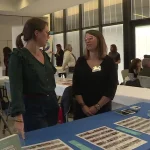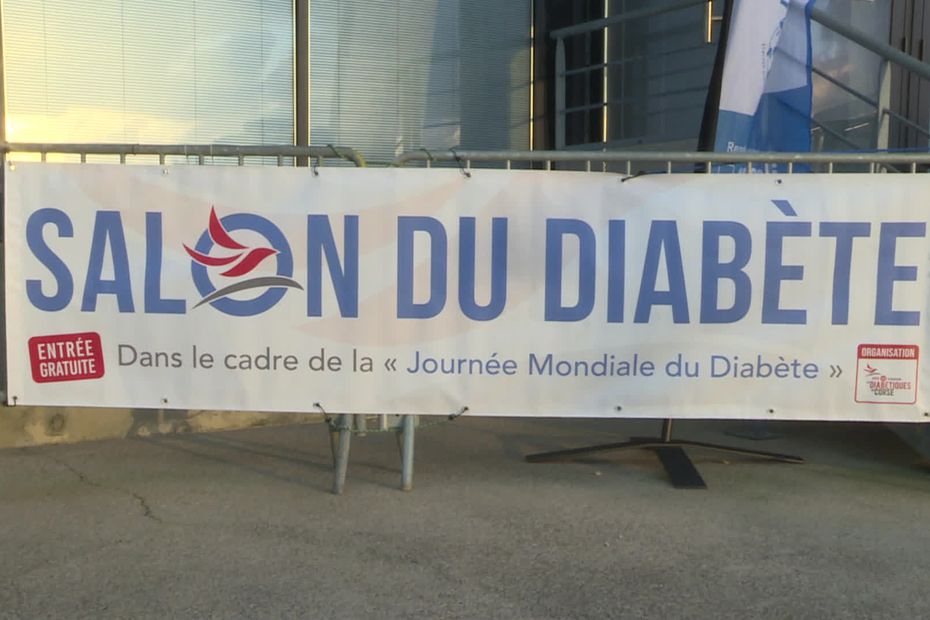


The eighth edition of the Diabetes Fair took place on Saturday November 11 in Porticcio. The opportunity to bring together all the professionals linked to the pathology and to provide as much information as possible to diabetics and those around them.
On this Saturday afternoon, many of them are strolling around the fifteen stands of the eighth Diabetes Fair organized at the Porticcio cultural center.
Three days before World Diabetes Day, several professionals from the sector (clinic, laboratory, health providers, endocrinologists, etc.) gathered on November 11 on the south shore of the Gulf of Ajaccio to raise awareness about this chronic disease characterized by the presence of excess sugar in the blood.
In addition to the round tables which took place throughout the day in the auditorium, a large audience – mainly made up of people with diabetes and their loved ones – was able to discuss and find the answers they had come to seek.
“The aim of this exhibition is to bring together all professionals directly or indirectly linked to pathology to provide all the necessary information to patients, their entourage and caregivers”explains Rose-Marie Pasqualaggi, president of the Association of Diabetics of Corsica which organizes the event.
Father of a 3-year-old girl who was recently diagnosed with type 1 diabetes (an autoimmune disease where the pancreas no longer produces insulin)Paul-Henri Santini came specially from Île-Rousse:
“We are here because it is important to raise awareness. Daily life is complicated because it takes a lot of time to take care of a diabetic child. Our little one is only 3 years old and there are a lot of variations at the level of blood sugar, whether at the level of hypers or hypos, in children, this is also due to emotions which fluctuate all the time, even at night with dreams. It’s complicated but we are still enough. well supervised: we have quite a few numbers to call in case emergency if we have questions, even at night. It’s really good to feel supported.”
In recent years, the care of diabetics as well as the medical equipment they use have evolved significantly. Particularly regarding the calculation of blood glucose levels. This is evidenced by the stand of this healthcare provider where sensors from different brands intended to measure blood sugar levels continuously are on display. Innovative devices that make patients’ daily lives easier.
“Today, treatments have really evolved, confirms Anne Faivre, 32 years old, type 1 diabetic since childhood. We have blood glucose sensors and insulin pumps. We can see our blood sugar results directly on our phone. We also have alerts if we are below or above the rate. Today, we can eat absolutely like everyone else if we calculate our carbohydrates correctly.”
Next to her, her twin sister, Elise, also a type 1 diabetic, turns the pages of the book they wrote together. They came specially from the continent to present it to the islanders:
“This book, which is called “Let’s Be Carbohydrates”, we wrote it with our words as patients for patients, specifies Elise Faivre. We explain in particular how we go from the quantity of foods, how we find the carbohydrates contained in these foods, and how we then calculate the dose of insulin to eat the food in question.
The two sisters, who also host a You Tube channel where they share their experience as diabetics, have a leitmotif: “you don’t adapt your life to diabetes but diabetes to your life”.
“When we discovered our diabetes in the late 1990s, we had a very strict diet, remembers Élise. We weren’t allowed sweets or candies. Over time, treatments have changed: insulins act more quickly, and you can adapt the dose to what you eat. From there, functional insulin therapy was created; it is a technique that allows you to adapt your diabetes to your daily life, and not the other way around. We can therefore make meals a little richer or lighter. We can also do sports now. We therefore wrote this book so that the patient can learn and train themselves at home in this method of calculating carbohydrates, which must be validated beforehand by a health professional.”
In the aisles of the show, we also come across type 2 diabetics, a chronic pathology which develops mainly in adulthood, notably in sedentary, overweight or obese people. It is the most common type of diabetes worldwide. In France, according to Health Insurance, 92% of the four million diabetics suffer from this type. This is the case of this man who discusses with Marie-Ange Moreau. Project manager in nutrition, she has a stand at the show:
“Do you know the glycemic index?” asks the young professional with a Bachelor’s degree in dietetics and nutrition, before expanding: “There are foods that will increase your blood sugar, others moderately, and others enormously. The important thing is to combine sweet foods together to balance this glycemic index. For example: if you take a fruit, it is better to eat it combined with fats and proteins rather than alone; you should avoid taking sugar in isolation; so you can combine your fruit with a piece of cheese or yogurt. dinner, the best is to make a balanced plate: half vegetables and whole starches or legumes and finally proteins in order to slow the arrival of sugar in the blood.”
“I therefore encourage people with diabetes to consult a nutrition professional. I would like to remind you that diabetes management is a multidisciplinary work between different health professionals.”
Marie-Ange MoreauNutrition project manager
If the message seems to have gotten through to this man aged around thirty, Marie-Ange Moreau regrets that “many diabetics are not followed at this level”.
“A lot of people I’ve talked to at the show aren’tshe specifies. Some doctors give some advice but it is not necessarily their specialty and they do not necessarily have the time. “I therefore encourage people with diabetes to consult a nutrition professional. I would like to remind you that the management of diabetes is a multidisciplinary work between the different health professionals who must be seen when you suffer from this pathology .”
If many diabetics met this Saturday in Porticcio say “live better” their illness than in the past, notably thanks to various innovations, some of them would now like to “even more efficient devices” : “it would be nice if they lasted longer, insists Anne Faivre. Currently, we can keep them for a maximum of fifteen days. We also want medical monitoring with whom we have good communication. It’s really very important.“
For Paul-Henri Santini, “psychological follow-up” for parents “wouldn’t refuse”. “It’s still an upheaval in life, it falls on us like that, he confides. There are also arrangements to be made, particularly at school. I also thank the teachers for the efforts made with my daughter. They really do more than they should. It’s very nice of them.”
A behavior which seems to go hand in hand with the evolution of treatments and a certain freedom of speech among people suffering from this disease.
“What’s changing is that patients are coming to us, underlines Rose-Marie Pasqualaggi, the kingpin of this show with the Association of Diabetics of Corsica. They realize that they need to get help to be supported with this pathology. They are increasingly going to see health professionals and doctors who are present at the show, such as endocrinologists who are the specialists in charge of this pathology. The important thing is therefore to talk about the disease and, as a result, we attract more and more people.”
According to figures from the association, nearly 21,000 people live with diabetes in Corsica. That is to say a prevalence rate 6.5% higher than the national average.




